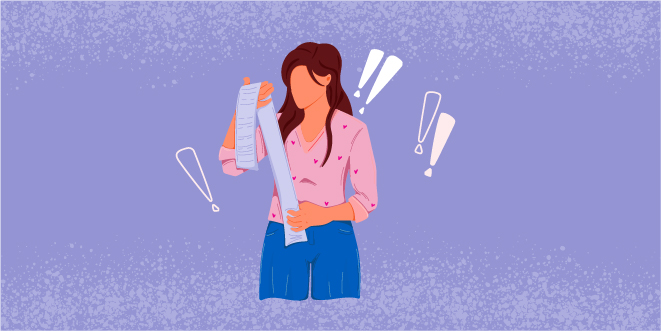How Inflation Is Making Your Period More Expensive

As record-high inflation continues and supply chain issues persist, eggs, gas, and car repairs aren’t the only things with skyrocketing price tags. Another daily living essential has been significantly impacted: Period products. Supply chain problems such as a tampon shortage and price gouging are putting an added strain on consumers who menstruate. In this article, we will discuss the Pink Tax, why menstruation is an essential right, and the ways inflation is impacting period products.
The Pink Tax
Even before the latest waves of pandemic-induced supply chain issues and global inflation started to affect the prices of period products, certain feminine products such as tampons, pads, and even razors that are specifically marketed towards women tend to carry an additional cost. You may have heard the term “The Pink Tax” before; it’s a common label referring to the discriminatory gender-specific pricing of services and products marketed towards women. For example, bright pink and purple packaged razors promoted as being “for women” cost more than the exact same products promoted “for men.” While a few dollars more here, a couple dimes there, may not seem like a big deal individually, cumulatively this cost differential can add up fast. On average, women pay 13% more than men for similar products, and rising prices disproportionately affect women and the menstruating population since they were already paying the “pink tax.” Moreover, there is also the “Tampon Tax,” an increase in state taxes on menstrual products that vary depending on the municipality, which we will discuss more in-depth below.
Menstrual Health As A Basic Right
Menstrual health is a critical component of sexual and reproductive health and reproductive rights. The U.N. High Commissioner For Human Rights released a statement last June addressing how menstrual health and access to menstrual sanitary products “is an important determinant for the realization of all human rights of women and girls in all their diversity, the achievement of gender equality and the Sustainable Development Goals.” Access to affordable menstrual products can be considered a basic right- one that inflation is sadly threatening.
How Period Products Are Being Affected By Inflation
Our grocery bills seem to be growing every month, but how and why exactly are period products being impacted by inflation? Let’s break down the ways inflation and supply chain issues interweave to continually hike price tags for basic menstrual products.
The Tampon Tax
Even without inflation, menstrual hygiene has already been facing cost increases from state taxes, including the “tampon tax.” Essentially, the “tampon tax” refers to state taxes levied on feminine products like tampons, pads, and diapers, which make up a significant amount of public revenue collection, and 30 out of 50 U.S. states have a state sales tax on period products. California collects around $55 million per year in just diaper and tampon taxes alone, and New York state collects an estimated $14 million annually from the tampon tax. The public revenue such taxes generate- and the undue burden they place upon the menstruating population- makes it difficult for states to reduce costs of essential feminine products, and since the taxes are a percentage of the cost of the item, when inflation goes up the costs are compounded by state and municipal taxes. In the EU and UK, the tampon tax was eliminated in 2022.
Rising Shipping Costs & Broken Supply Chains
There isn’t just one specific cause for the price spike; manufacturers often have no choice but to pass on higher costs for key components and logistics like transportation. The U.S. government’s latest producer price index reports that prices for plastic resins and materials were up by 9.5% in April 2022 compared to the year before, and cotton futures were up by 40%. The rise in material costs along with transportation and fuel prices contributed to the average unit price of tampons in the U.S. jumping over 10% higher year-over-year each full month in 2022, and the price of sanitary pads being over 10% higher year-over-year per month since April 2022.
Lack Of Federal Support
There’s another barrier to equal menstruation product access: U.S. federal government programs for low-income households such as the Special Supplemental Nutrition Program for Women, Infants and Children (WIC) and the Supplemental Nutrition Assistance Program (SNAP) do not cover menstrual products. Menstrual inequity, or the unequal access to essential sanitary products, is a major problem because it forces many people to rely on less sanitary options like old rags, diapers, napkins, and newspapers, which can result in serious infections and toxic shock syndrome. Period poverty is a global issue that even in a wealthy country such as the U.S. affects around 16.9 million people.
Fighting Period Poverty
Period poverty impacts women worldwide by limiting their ability to work or attend school when they’re menstruating. Even before the pandemic, women were having trouble affording menstrual products; one pre-pandemic study in Obstetrics & Gynecology notes that 64% of women reported having difficulty at some point affording menstrual products, and another 21% reported that they couldn’t afford these products on a monthly basis.
To combat this, reusable options such as menstrual cups that can be easily sterilized as well as disposable products like pads and tampons need to be tax-free and subsidized. Pads and tampons should be distributed at all public schools and health care facilities, and the 22 million women who live in poverty in the U.S. as well as the enormous global population should have equal access to such essential products.

Clara Wang is a freelance writer based in Nashville, TN but often found abroad. She mostly muses about the three best things in life: Food, sex, and music. Her work has been featured in publications such as Eater Austin, Eater Nashville, Giddy, Buzzfeed, Refinery29, the Austin Chronicle, the Austin American Statesman, and the Daily Dot.


